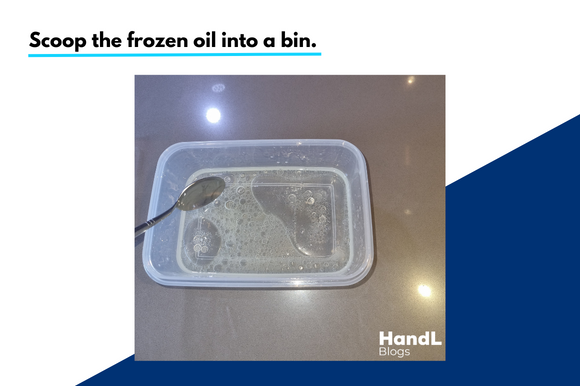A Step-By-Step Guide On How To Dispose Of Cooking Oil - Tips On How To Recycle Cooking Oil & More!
Luke Iles – Uploaded 06.01.2023


How to dispose of used cooking oil at home?
Picture the scene, you have just finished cooking your favourite meal for the whole family dinner and you need to dispose of the leftover cooking oil. Many people would think to simply chuck it down the kitchen sink as you would normally do with other food and drink waste products like leftover drinks, juices and sauces.
However, disposing of cooking oil down the sink can be one of the worst practices you can do within the kitchen and can leave you having to waste hundreds of pounds on unblocking your kitchen sink! With the cost of living so high in the UK at the moment, it is an obvious choice to avoid doing things which may end up costing you a fortune and simply correctly disposing of your cooking oil after you are finished with it, is an easy way to help you avoid unexpected maintenance costs and having to fork out for a new kitchen sink drainage system.
Fortunately, this guide will take you through all the necessary steps to help you avoid having to fork out a shed load of money on unblocking your sink drainage system and instead not only save you money but also help you be more environmentally as well.
Sounds too good to be true?
We can assure you it is the complete opposite!
How to dispose of cooking oil - a step-by-step guide

Step 1 - Wait for the cooking oil to cool down.

Firstly, before even thinking of disposing of the cooking oil, you must ensure that the cooking oil has cooled down to room temperature. This is due to the fact that if you were to spill any of the cooking oil from the pot, pan or frying pan onto yourself or someone nearby this could cause serious first-degree burns and injury. On top of this, do not pour hot oil down the sink because hot oil has been proven to be more likely to clog your drainage system as it begins to cool down as it passes through the pipes and is more likely to cause a blockage. It is important to remember that if you have a large amount of cooking oil to dispose of, it may take a few hours to cool down. If you are cooking in the evening, it is safe to leave to cool overnight if needs be.
Initially, you must turn off the hob and leave the pan on top, to cool to room temperature. Wait around 30 minutes, ensuring that the waste cooking oil is now cooled down to room temperature, and carry on to the next step of disposal.
Tip – If you have a small amount of cooled oil in a pan, you can simply use a piece of paper towel and soak it up and dispose of the used paper towel. Just ensure you have waited till the pan and oil has cooled down first!

Step 2 - Dispose of the cooking oil in a sealable container.

Next, you want to place the cooled cooking oil into some sort of sealable container. This could be anything from an old plastic container, tub, carton or even a used plastic bottle of some sort. If you are planning on re-using the oil, we recommend using a plastic container that has a lid and can be cleaned.
Ensure that you have labelled the specific container that you are going to put the cooking oil into as “used cooking oil”. This will prevent someone from accidentally reusing the oil and will avoid any mixups when it comes to the next step.

Step 3 - Freeze the cooking oil.

A clever way to avoid attracting rodents and pests and be more environmentally friendly is by freezing the oil before disposal. Sure it is all well and good throwing the oil away in a sealable container however it is hardly environmentally friendly and if the oil escapes from the container into the actual bin, this can provide you with a number one ticket to an infestation of rodents and pests!
To avoid this and to also play your part in saving the planet, simply place your container full of cooled cooking oil into the freezer for a few hours. This will freeze the oil and make it into a solid waste that you can simply scoop out into your general waste bin. Not only does this contribute to being more environmentally friendly because you are not throwing away a piece of unrecyclable plastic every time you dispose of your waste cooking oil but you can also easily reuse the same container again and again. Just make sure to wash it out after every time you scoop out the used cooking oil.

Tip – If you have a large amount of cooking oil you need to dispose of it and do not have the space in the freezer to freeze your cooking oil and dispose of the waste cooking oil that way. All you need to do is after the used cooking oil has cooled down off of the hob, take your cooled cooking oil and pour the cooking oil into a large plastic bin bag. Ensure that the bin bag has some rubbish inside it already such as used paper towels or some food leftovers. Next, tie it up at the top and place it into your general waste bin.
Can I recycle cooking oil?

Cooking oils are known to cause blockages within the drainage systems if you pour the leftover oil down your sink and should be disposed of correctly instead. Many UK households worry about how to actually dispose of used cooking oil and are unsure of the correct way to recycle cooking oils correctly. Fortunately, we have also created a step-by-step guide on how to recycle cooking oil below!
Step 1 - Always ensure the cooking oil has cooled down.
As mentioned previously always ensure that the cooking oil has cooled down before trying to dispose of it. The best practice is to turn off the hob after use and wait a few hours for the cooking oil to cool to room temperature. If you attempt to carry the hot cooking oil, you could spill it on yourself or another person and cause serious harm.
Step 2 - Pour into a container to dispose of the cooking oil.
Once the used cooking oil has cooled down, pour the waste cooking oil into a sealable plastic container that has a label identifying it as “recycled cooking oil” or “used cooking oil”. Ensure that the container is strong and won’t break like a glass container. From here, store the used cooking oil in a cupboard or on a worktop at room temperature.
You now want to identify and find a way in your local area to recycle your used cooking oil.
Step 3 - Identify a cooking oil recycling scheme in your area.
Browse online or call your local recycling centre or local council about the best ways to dispose of cooking oil in your city. Each local council and recycling centre offer different services with some offering cooking oil disposal and pick-up services from your home. Some local recycling centres may offer a service where you have to dispose of your used cooking oil by visiting the recycling centre yourself. Some companies who produce biodiesel may even offer to collect your cooking oil for free because they can use it to produce energy to power cars. The best way to find out how to dispose of your used cooking oil is by searching online and doing some research.
What types of cooking oil cause drainage build-up?
A common question people always wonder is if there is a specific type of cooking oil that can cause less damage and less chance of a blockage than other cooking oils. When it comes to disposing of used cooking oil, it is always a bad idea to pour the cooking oil down your sink no matter what type of cooking oil you use. Whether that is sunflower oil, grease, goose fat, olive oil, rapeseed oil, you name it – every type of oil when poured down the sink has the opportunity to harden once it cools down and pool within your sink’s drainage system. This can cause something known as a fatberg which is an accumulation of oils and fats that have been poured down the sink and cooled within your pipes. Once cooled these oils can harden and stay stuck in your pipes causing blockages and resulting in a hefty fee to call out a plumber to fix it!
Conclusion
In conclusion, it is always wise to follow the steps we have noted in our guide if you want to not only avoid damaging your kitchen sink plumbing system and having to fork out a load of money but also to go by best practices and actually be more environmentally friendly. Throughout this cooking guide, we have detailed the best ways to dispose of your used cooking oil as well as how to recycle used cooking oil. These steps have hopefully provided a competent and easy-to-follow guide which you can replicate quickly at home and not have to opt to just chuck the grease and cooking oil down the sink but instead dispose of it correctly and in turn, help save you some money and inconvenience in the long term!
Read More Cooking Blogs From HandL Blogs
Disclosure: Some links in this article may be affiliate links, which can provide compensation to HandL Blogs at no cost to you if you decide to purchase through these links. These are products we have personally used and stand behind. This site is not intended to provide financial advice and is for entertainment only. You can read our affiliate disclosure in our privacy policy.

Luke Iles
Luke is a leading travel writer within the travel niche and is also a co-founder of HandL Blogs one of the UK’s leading travel blogging websites. Luke has a love of all things travel.
Initially becoming friends with his other co-founder, Harry, at the age of four years old, they let their love for travel evolve, making it their mission to visit every country in the world!
Today they want to share their passion and experiences of travelling across the globe with written blogs on topics that are most important to them. From travel, cooking, fitness and tech blogs!
Whether that be trying new food in a new country and sharing it in a cooking blog; visiting a new gym in a certain city and reviewing it in a fitness blog or learning about the newest tech within the travel industry.
Disclosure: Some links in this article may be affiliate links, which can provide compensation to HandL Blogs at no cost to you if you decide to purchase through these links. These are products we have personally used and stand behind. This site is not intended to provide financial advice and is for entertainment only. You can read our affiliate disclosure in our privacy policy.
